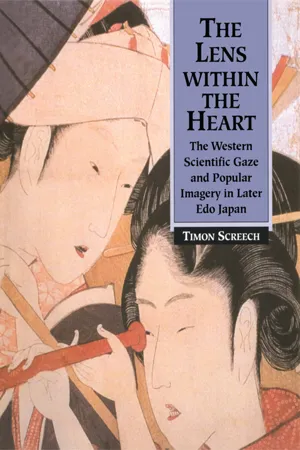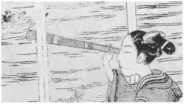“THE NUMBER OF PERSONS engaged in this study [of the West],” wrote Takano Chōei, “does not exceed one or two in 10,000,000.”1 This statement has about it the hyperbolic glumness of an expert who cannot imagine why others lack excitement for his own small area of concern. But the words suggest something truer of what was generally felt by those who developed enthusiasms for Europe in Edo-period Japan (1603–1868). Chōei was writing in 1839. The situation had fluctuated during the late eighteenth century, and the stock of Western things had risen to a peak in the 1780s; but predominantly the state of affairs remained little different, and certainly offered no cause for jubilation.
Holland as Discourse
Historians have written about Rartgaku scholars before now, and of the role they played in disseminating ideas of the West has received plentiful attention; a generally positivistic approach has been taken, with the underlying assumption that the best work lies in identifying those responsible for the forgotten groundwork that allowed Japan’s spectacular modernisation in the nineteenth century.
The thrust of this book is different. Rather than bringing to light the lost archives of “pioneers”, I propose to look at what “Holland” meant to the mind of the time and, as a willed construct, what it did. It is precisely the dilatory persons who ignored the overt challenge of Rangaku who provide our samples. The focus here is on those 9,999,998 who, according to Chōei, never sought in the West a comprehensive (or even partially coherent) alternative to the life they lived, but who consumed it none the less, for their own ends. Rather than turning Rangaku into the centre of eighteenth-century debate, we shall keep it in the margins but consider how, being there, it contributed to meaning and affected thought. In sum, Rangaku mutated from being a discourse of assessment of the foreign to a popularised resource operating piecemeal and adduced to answer questions having to do with the self. It is a premise of this book that “Holland” was internal to Japan and detached from the West. For sober Rangaku scholars trying to keep the discipline on track, this would not do: “Many know some facts,” complained the prolific Shiba Kōkan, prominent for almost forty years from the 1770s, “but few understand the theories.”4 Yet those dilettanti who only really wanted easy tidbits, and lacked concern for categorical disquisitions on far-removed things, are precisely the ones who will absorb us. Imbibing their “Holland” – and this is the point – on their own terms, these people felt a change occur.
The Japanese abbreviation of Holland, Ran, is retained here to mean that local reading of the West which was built up from imported ideas and materials. Rangaku was an academic pursuit; Ran, a patina of foreignness, directed inwards. Our artifice of Ran was essentially vulgar. But I maintain it enjoyed vastly important currency throughout the late-eighteenth century.
Ran was a cluster of concepts, not a place. Any attachment to life in the Republic of the United Provinces was quite tangential. The Netherlands, in any case, was chronically unstable at the time: 1795 saw the United Provinces become the Batavian Republic; in 1805 it changed into the Batavian Commonwealth, in 1806 into the Kingdom of Holland, and after 1810 was made a département of the French Empire; in 1814 it became the Kingdom of the United Netherlands.5 This epistemic flux gave free rein to Japan. Yet the realisation that outside the national borders were real people who surrounded themselves with strange and different effects grew, and the sense that persons in foreign lands fathomed lives infinitely unlike those at home, agitated and stirred the status quo.
I take a materialist stance. The argument here is principally for a new mentality culled from imported things. Trade was brisk for all that Holland alone among Western countries possessed a supply network in Japan. Import of European goods wavered and changed in type over time: what Europe was pushing into foreign markets in 1800 was not the same as it had been in 1700. But I hold that a steady flow of objects found its way into Japan, and that the range of items to be seen, at least by the people of the larger cities, was not small. It is necessary to stress this, for many still argue for an eighteenth-century Japan closed to the outside world. The greatest conurbations all had their few Rangaku experts and their many lay enthusiasts fixated with a notional Ran. The latter fed off visible or purchasable artefacts. People in Edo, the shogunal seat, home to perhaps a million souls, and Osaka, the “nation’s kitchen,” Kyoto, the cultural heartland, and Nagoya, the shogunal collaterals’ Western base, knew the look and feel of foreign goods. Nagasaki was the port of access for foreign vessels and the location of the Dutch trading station (or “Factory”).
The Dutch Factory dealt with many mundane items – sugar, copper, cloth – and by these it earned its keep. But such were not the affairs that propelled Edo culture into new domains. That role was played by fringe imports: telescopes, microscopes, spectacles, prisms, kaleidoscopes, static-electricity generators, glasswares, glass panes, projectors, candelabra, clocks, toys, prints, peepshow boxes, scissors, penknives, wine, sweets, flora and fauna, and books. The bulk was known under the generic title of “strange devices” (kiki). Spreading far and wide, they were immensely appreciated. All cities saw the public display of objects, often at events where they could be handled or used, and strange devices were not necessarily the preserve of the rich. The custom of putting out oddities on show (misemono) long predated the arrival of much in the way of European manufacture, but by the mid-eighteenth century imports were making frequent appearances at exhibitions, and by its end may be said to have abounded.6 Stalls were set up in vacant plots, behind a temple precinct, in a dry riverbed, or atop a dyke or embankment, and the rarities revealed for a fee by small-time impresarios. It is from the contents of such jerry-rigged huts and from the brushes of those who composed their advertising cant or wrote about what they had seen when they got home, not from academical treatises on heliocentricity, Dutch government, or European law, that what the West was, as we understand it here, is to be discerned. The length of queues at fairgrounds reveals how much “Holland” had to offer on a personal level.
The discourse of Ran was popular and detached; it brooked no priority in Holland’s own interpretations of itself – indeed, it openly dismissed them. But even so, Ran was held in a grip of some firmness through the agency of the materiality of imports. “Holland” did not float quite free, but was moored to the objects encountered. Many misemono items were of a semi-technical nature, and this gave rise to a sense of certain innate qualities in all the things of Ran. Supreme was the notion of precision. The Dutch, it was said, were close-crafting and adept, and must needs be punctilious and nice to have made such wondrous fabrications. Many goods attested to an impulse to enhance vision. Optical devices were in great evidence, and the West came to be considered as a place where empirical sight was augmented or reformed, and where people used (and abused) their eyes.
The Dynamics of Trade
The Factory in Nagasaki was run by the Dutch East India Company. In Japanese it was called Konpanya (from Compannie). By felicitous coincidence the suffix -ya denoted in Japanese a business enterprise, so the function of the foreign entity was easily explained. The Company’s own acronym was VOC (Vereenigde Oost Indische Compannie), and for brevity that is used here.
The VOC had been in Japan since 1609.7 In its early days it had been in rivalry with Iberian traders who had arrived some four decades before in the trail of missionaries; the English East India Company was soon to appear as well. But fear of the unsettling effects of Catholicism (the Japanese authorities knew what had happened in Mexico) resulted in expulsion of the Spanish and Portuguese in 1639 – and apostasy or death for local Christians. The English had withdrawn voluntarily sixteen years earlier, unable to turn a decent profit; their attempt to return in 1673 in a ship named The Return was thwarted when it was learned that Charles II had married a Catholic queen.8 From 1639, for the next 229 years until 1868 when the shogunate finally fell, the Dutch operated alone. But the monopoly was not absolute, for European nations had wrestled concessions in China, and produce could arrive via transshipment in privately owned Cantonese junks or aboard bottoms of overseas Chinese from South-East Asia. Chinese trade with Japan was not subject to the same geopolitical limitations as that with Europe, and reputedly thirty or so Chinese vessels were to be seen docked in Nagasaki at any one time.9
Japan had been a major international trading nation until the mid-seventeenth century. Thereafter volume shrank dramatically: the VOC sent only two ships per annum. The disappearance of overseas ships was coupled with new restrictions on Japanese travelling abroad and the calling in of residents from the Japantowns dotted through maritime Asia. This was the policy of the Tokugawa family. They had assumed power after protracted and bloody civil wars and founded their shogunate in 1603. It held for fifteen generations. The Tokugawa were keen on trade but disposed to encourage it only in measures that they could keep under their control, directly or through intermediaries. The post-1630s clamp-down is to be seen less as distaste for the exchange of goods per se, than as the result of a faute de mieux acceptance by the Tokugawa that the best way to guard the peace was by preserving mercantile receipts for themselves and not letting a free flow of goods dilute their authority and enrich the regional lords. The nation was terribly friable.
The Japanese archipelago was divided into some 280 domains (han) over which the shogun had a federalistic central control; but the han were semi-autonomous and ruled by hereditary lords or daimyo, some of uncertain loyalty. It was no more than prudent to deny them access to independent means of creating wealth.
Decades of intensive commerce around the turn of the sixteenth century had seri...

